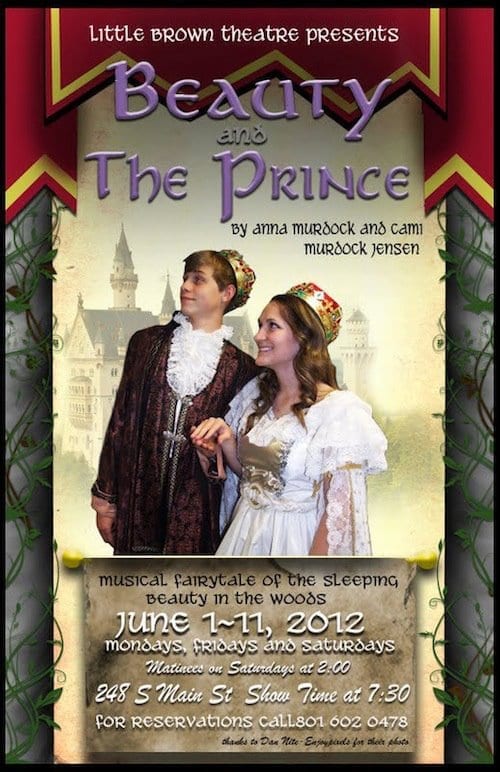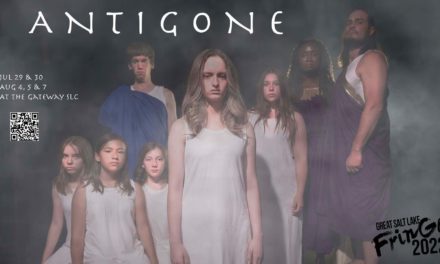SPRINGVILLE — Beauty and the Prince by local playwrights Anna Murdock and Cami Murdock Jensen is now playing at the Little Brown Theatre is Springville. Directed by Amanda Oliver, it is a traditional fairy tale, complete with fairies, ogres, an enchanted castle, a handsome prince and his lovely princess.
The play opens with Katie Donnelly as Goodwin reading the audience a story of a good King and Queen (Adam Argyle and M’Liss Tolman) from long ago. The actors and actresses then live out their parts of the royal subjects that longed for an heir to the throne. They are soon engulfed in hurried preparations for a baby’s arrival. All rejoice when they are introduced to a princess named Beauty (Isabel Moss as the younger and Jeannie Hawks when she’s come of age).
A grand celebration is planned for the new member of the royal family, but in the midst of preparations, the Queen and King receive bad tidings from another kingdom. There is a plague, and their neighboring king asks that they keep and protect his son Justice (Jaden Stulce as the youngest, Nathan Shallenburger as the younger, and Dallin Bradford when he’s all grown up). Justice is welcomed, but more ill news soon follows. By mistake, one of the four fairies in the neighboring forest was not invited to the party welcoming Beauty. Evil Fairy Malicious (RachelAnne Kersh) is offended and curses Beauty on the day of the celebration: she is to prick her finger on a spindle the day of her eighteenth birthday and die. Horrified, the King and Queen look to the other three fairies for their help. Fairy Faith (Lisa Steele) cannot cancel the curse, but she can alter it. Instead of dying, Beauty will fall asleep for one hundred years and will only awake with true love’s kiss.
Despite the best efforts of the royal subjects to burn all the spindles in the kingdom, Beauty does prick her finger on a spindle and fall into a deep sleep. The King and Queen mourn for her, knowing that they will die before she wakes up. Seeing their sorrow, the good fairies give them an opportunity to join Beauty in her long rest. The King and Queen, along with their subjects, agree to a nap lasting one hundred years. Shortly after the kingdom falls asleep, Justice arrives. He had returned to his own kingdom for a short while, but has come back to see Beauty. He finds the castle locked up tight, and Goodwin explains the curse and all it entails. Knowing that he, alone, can rescue Beauty, Justice also sleeps for one hundred years. Upon waking, he finds that Malicious has used her black magic to prevent him from entering the castle.
For such a piece of fantasy with period locale and costume and a relatively large musical cast, the Little Brown Theatre stage is a very small space. Given the constraints, Oliver was able to make this production work, however, with functional set design and staging; there were only a few close encounters between actors and audience. The choreography, by Jacob Harvey and Chantelle Peck was a little cramped, but this would be expected. The positive benefit of the intimate setting is that the audience is rather engulfed in the production; it seemed as if we were fellow-members of the court at times.
Despite the small space, Beauty and the Prince is a good choice for The Little Brown Theatre. The play seems intended for community theatre, with a large, multi-generational cast and with a story that is geared to young and old alike. (Who doesn’t love a good fairy tale?) The songs are fun, and there are plenty of physical comedy bits, the best by the youngest members of the cast. There are also some noteworthy visuals in the production (a giant evil spider battles with Justice), and most of the costumes, by Melissa Zanandrea-Tice, are fairy-tale fancy. The fight choreography, by Jakob Tice, is another positive element of the production.
This said, Beauty and the Prince does have some problems. In addition to predictability, which can be excused in light of its fairy tale status, the play is far, far, far too long. Because it is a fairy tale and, in many ways, already “familiar” to the audience, there could be far less explanation, exposition, and character building. While the length does allow some of the more minor characters an opportunity to shine, this is at the detriment to the pace of the play. While this flaw is inherent to the script, pacing issues in this production contributed to the feeling that the two-hour production (with intermission) was a little longer. Though the beginning skipped along, the latter half of the musical dragged. Toward the end of the evening, it felt a little as if the audience was also waiting one hundred years for Beauty to wake up. To be sure, opening night could have contributed to this, and some of the long pauses may shorten in subsequent performances.
The acting, as I have found in most community theatre, was fervent. The performers engulfed themselves in their characters, and the joy of their craft was evident. Stand-out performances include Abby Young as Monique, the castle’s cook, and RachelAnne Kersh as the evil Malicious. Overall, though, I commend Oliver and her cast for their work and believe that they provide a suitable evening of good-old-fashioned whimsical fantasy.




![ALIENS (THE PUPPET MUSICAL)—even in space you could hear us scream [with laughter]](https://utahtheatrebloggers.com/wp-content/uploads/2012/05/ATPM-Publicity-Photo.jpg)


